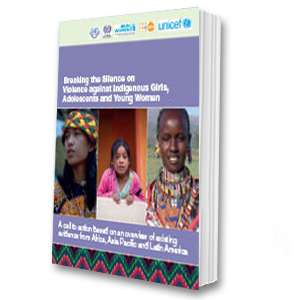pdf Breaking the Silence on Violence against Indigenous Girls, Adolescents and Young Women
1548 downloads
Breaking the Silence on Violence against Indigenous Girls, Adolescents and Young Women.pdf

About the research
Addressing disparities in development outcomes of marginalized and excluded groups such as those of indigenous background is central to all sustainable development efforts. This study represents the first attempt at consolidating existing evidence on violence against indigenous girls, adolescents and young women and is based on a recommendation of the United Nations Permanent Forum on Indigenous Issues to United Nations agencies to address gaps in knowledge on the magnitude, nature and context of violence against these groups. It is in step with similar recommendations arising out of the United Nations Secretary-General’s 2006 studies on violence against children and violence against women respectively.
Using illustrations from Africa, Asia Pacific and Latin America, the study reaffirms the universality of violence across all socio-economic groups and cultures but finds that violence is heightened for indigenous girls, adolescents and young women when their communities’ broader contexts – such as colonial domination, continued discrimination, limited access to social services, dispossession from ancestral lands, militarization and intercommunal conflicts – intersect with personal circumstances such as age, sex, ethnicity and by patriarchal value systems of indigenous and wider societies.
This study finds that the types of violence which have been documented with respect to indigenous girls and young women are embedded in a narrow space of evidence which, though widening through a number of qualitative and quantitative sources remains insufficient.
Notwithstanding the noticeable gaps in information, the report aims to spur a call to action to governments, United Nations agencies and special mandate holders, indigenous communities, and women’s and children’s rights organizations to work collaboratively to end the impunity of violence. It also aims to tackle issues such as the structural, underlying causes and risk factors that lead to violence while paying close attention to deficits in information and strengthening of the capacities of government institutions and civil society organizations in preventing and responding to violence.

